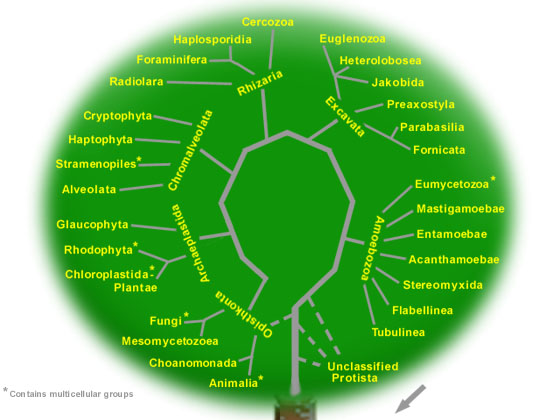Domain Eukaryota |
 |
The Eukaryota include all organisms composed of cells that have a membrane-bound nucleus and membrane-bound organelles. The genetic material is organized in chromosomes in which the DNA is combined with histone proteins. Eukaryote cells are comparatively large, These characteristics separate the Eukaryotes from the Prokaryotes (the Bacteria and Archaea). Included in Domain Eukaryota are numerous taxonomic kingdoms of Protists (single-celled organisms), Algae kingdoms, and the Fungi, Green Plant, and Animal kingdoms. Domain Eukaryota is extremely complex - partially because the Eukaryotic cell was built by endosymbiosis, and partially because of the genetic diversity generated by the development of sexual reproduction. Conclusively classifying the Domain has perplexed biologists for decades. But modern morphology, biochemistry and genetics continue to clarify the picture. The tree shown here is based on a revised classification consensually developed by a committee of eukaryotic specialists. (Eukaryotes are distinguished from prokaryotes by the presence of a nucleus. The nucleus is defined as an organelle bounded by a double membrane, the outer being derived from the endomembrane network, with the nuclear pore complex traversing both membranes, and with one or more linear chromosomes typically packaged by histones and usually with a centromere and telomeres. We recommend restricting the use of cyst to vegetative quiescent stages, while restricting the use of spore for reproductive stages. The eukaryote motility organelle is the cilium, or ‘‘eukaryotic flagellum,’’ which consists of a cell membrane-bound extension supported by a microtubular-based axoneme and a basal body or kinetosome with associated cytoskeletal elements serving as anchors.)
|